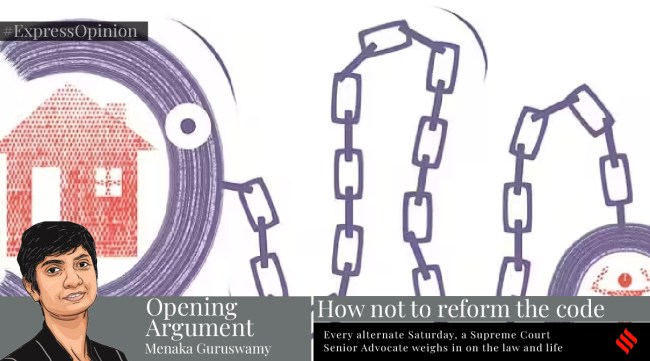Opinion Menaka Guruswamy: How not to reform Criminal Code
New Bill enables seizure of movable and immovable assets as ‘proceeds of crime’ under general criminal law — without any of the necessary procedural safeguards writes:
 It’s important to note that the CrPC, unlike the IPC and the Evidence Act, has been reformed a bit more consistently in independent India. (Illustration by C R Sasikumar)
It’s important to note that the CrPC, unlike the IPC and the Evidence Act, has been reformed a bit more consistently in independent India. (Illustration by C R Sasikumar)
In the past few columns, I wrote about the State’s plans to introduce the Bharatiya Nyaya Sanhita, 2023, to replace the Indian Penal Code, 1860 (IPC), the Bharatiya Nagarik Suraksha Sanhita, 2023, to replace the Code of Criminal Procedure, 1973 (CrPC), and the Bharatiya Sakshya Bill, 2023, to replace the Indian Evidence Act, 1872. These Bills have been tabled in the lower house of Parliament. At present, the Parliamentary Standing Committee on Home Affairs tasked with assessing them has commenced its hearings.
In a previous column titled ‘The Custody Question’ (IE, August 19), I had discussed reforms — both positive and negative — in the Bharatiya Nagarik Suraksha Sanhita, 2023 (BNSS). Subsequently in ‘Weakening Law’s Guardrails’ (IE, September 2), I wrote that with these new Bills, the State was working at odds with the established legislative practice of keeping specialist harsh statutes with extra procedural safeguards distinct from general criminal law. For instance, specialist legislation includes statutes like the Prevention of Money Laundering Act, 2002 (PMLA) and the Maharashtra Control of Organised Crime Act, 1999 (MCOCA). This column will discuss the introduction of “proceeds of crime” and “attachment of movable and immovable property” of persons under the BNSS. This brings PMLA-like provisions into general criminal law by way of the BNSS, with no corresponding protections.
It’s important to note that the CrPC, unlike the IPC and the Evidence Act, has been reformed a bit more consistently in independent India. Not only is the statute in its 1973 form, but the provisions that we will discuss were introduced by the legislature in 1993. Hence, the logic of the State — that British colonial laws will be reformed — does not hold good.
What kind of powers does CrPC provide with regard to attachment of property? Section 102 gives a police officer the power to seize property. At present, “any police officer may seize property which may have been alleged or suspected to have been stolen”. Alternatively, “which may be found under circumstances which create suspicion of the commission of any offence”.
In 2005, safeguards were added to this power of seizure, whereby the legislature provided that the seizing police officer must “report the seizure to the magistrate having jurisdiction”. Finally, the Supreme Court confirmed in 2019 in Nevada Properties Private Limited that the meaning of “property” in this section does not extend to immovable property (house or buildings). Therefore, the person was protected from her home or other immovable assets being seized. However, the CrPC does enable seizure of immovable property in specific circumstances. The CrPC has a special chapter VII A applying to ‘Reciprocal Arrangements for Assistance in Certain Matters and Procedure for Attachment and Forfeiture of Property’. This chapter makes provision for attachments of “proceeds of crimes” which have “international ramifications”.
The Supreme Court in State of Madhya Pradesh v Balram Mihani observed that in the Statement of Objects and Reasons to the amending Act 40 of 1993, to Chapter VII A it is clearly stated that “the Government of India and Government of the United Kingdom signed an agreement for extending assistance in the investigation and prosecution of crime and tracing, restraint and confiscation of the proceeds of crime (including crimes involving currency transfers) and terrorist funds, with a view to check the terrorist activities in India and the United Kingdom.”
In this decision, Justice Sirpurkar makes clear that Chapter VII A was not meant for “general offences and the properties earned out of those general offences in India”, meaning that the whole chapter “is a specific chapter relating to the specified offences therein and has nothing to do with the local offences or the properties earned out of those.” When a letter of request is received by the central government from a contracting state making allegations about a person’s property as a result of her involvement in terrorism, then such property can be attached, after this request has been sent to a court of law in India. The Supreme Court has made clear in Balram Mihani that this attachment cannot be done for offences that are local in nature and committed within the country.
The court has warned that if Chapter VII A was extended to local offences, then it was liable to be misused.
It’s not only on allegations of international terror that property can be seized or attached under the existing legal regime. But, it’s the specialist harsh statutes like the PMLA with heightened safeguards that facilitate this, not general criminal law. The current statutory regime does enable seizure of immovable assets like a home or a building or any other immovable property owned by an accused on charges of money laundering.
Section 5 of the PMLA enables the attachment of property by a director or deputy director of the Enforcement Directorate, after recording reasons in writing justifying their belief that a person is in possession of “proceeds of crime”, and attachment of such property can be done for up to 180 days. The safeguards in this provision include the high-ranking officer recording reasons in writing for the seizure. A further requirement is that the attachment order “must be in relation to a scheduled offence, and a report has been forwarded to a Magistrate”. The “scheduled offence” is one that is present in a specific schedule or list to the PMLA and includes offences like forgery and cheating. The judge here is expected to apply her mind. Such a process can be dispensed with only if the need for “immediate attachment” is justified by the officers, as being necessary, failing which the non-attachment would “frustrate proceedings” under the PMLA.
The BNSS bill is in sharp contrast to this mechanism of safeguards. Section 111(d) enables the seizure of both movable (papers) and immovable property (house), deeds, instruments of title, among other types of interests, if “a police officer making an investigation has reason to believe that any property …. is obtained from proceeds of crime.” She may, with the approval of the Superintendent of Police or Commissioner of Police, make an application to court to make a case for attachment.
Importantly, the BNSS enables the attaching of a person’s home to the title papers for the home on suspicion of it being a result of “proceeds of crime”. And that crime can be a local offence, unlike the present law which mandates it must be an international offence involving terror or of offences of heightened international consequence.
I have written in the first part of this series that the current law reform effort by the State is at odds with established legislative practice of having separate and distinct harsh “special statutes” with procedural checks and balances. This current effort shows that special laws are being absorbed into general criminal law — without any of the necessary procedural safeguards.
When this happens, it enables the use and abuse of attachment of property powers by the State. More importantly, this is only one example of the State moving away from this established legislative practice of harsh criminal statutes being specialist in nature, with additional safeguards.
When the process becomes the punishment, it is likely that this will result in persecution of the accused, poor investigation by agencies, and fewer convictions by courts. This must not be the outcome of our law reform efforts. The legislature needs to be thoughtful in its approach and consult widely before going ahead with what otherwise might become the undoing of criminal justice in India.
The writer is a Senior Advocate at the Supreme Court





